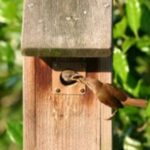If your backyard is currently a birdhouse-free zone yet you like birds, you should definitely consider providing housing for your feathered friends this year. But when is the right time do it? And where should your birdhouse be placed to give it the best chance of becoming inhabited? Because let’s face, it a birdhouse WITH birds in it is much more fun to watch than one without birds in it and, besides, it’s kind of the whole point.
Whenever you get your birdhouse, put it up regardless of the season. You may not get a taker right away but the right one will come along soon enough. In the fall and winter some birds may need shelter from the harsh weather. And then in the spring birds will be ready to nest and await their young.
Even in the summer you may find birds moving in that were forced out of their first homes because of predators or other unfavorable conditions. Who knows? Maybe new construction took down their cozy nest in some tree or maybe they got too many bugs in the nest. Birds have their reasons. And then there are those birds that lay eggs several times a year. All this means that you could get a bird in your birdhouse almost year-round.
However, the absolute best time to offer a birdhouse is in the early spring. This is when many birds are mating and laying their eggs. They need a good safe, place to nest. Again, anything can happen though, so don’t despair if you’re already into late spring and your birdhouse is still bare. There may still be some stragglers who’ve just found their mate.
To up the odds that your birdhouse will be lived in, be sure to follow a few simple rules:
– Position your birdhouse so it will be relatively safe from predators. This means on a pole away from trees or areas that can serve as launching pads for cats or other ground predators. If your yard makes this kind of placement difficult, consider putting a guard around the birdhouse to keep larger animals out. These can be bought or made out of mesh suitable for the type of bird you hope to attract.
– Face your birdhouse away from the wind. Observe the predominant winds in your area before you decide where to put it. It’s a nice touch for your potential bird neighbors since appropriate placement will help keep them dry when it rains.
– Provide a nearby perch. While you don’t want to provide launching pads for predators, a nice little branch or bush somewhat close to the birdhouse will allow your new neighbors to stop and take a look around before making their way to their new home. They will be able to assess the yard conditions and find any potential problems.
– Consider placing multiple birdhouses. Give your birds the opportunity to choose the house that suits them best. If you go this route, don’t over do it! According to the US Fish & Wildlife pamphlet “Homes for Birds”, you shouldn’t place more than four small birdhouses or one large one per acre. Don’t put the birdhouses right next to each other either. Be sure to keep them well apart – across the yard or in different trees.
– Offer food and water. Having a bird bath or pond and a bird feeder will assure your birds that all their needs will be taken care of in one yard. Spread food, water and birdhouse across your yard though. Putting a birdhouse right next to a feeder or water will generate way too much traffic and keep birds from wanting to nest there. Would you want your house right next to an always crowded buffet?
Finally – place your birdhouse knowing that if you don’t attract any birds, you can try again. Wait a significant amount of time (a year if you’re patient enough) and then move it somewhere else. Eventually you will be rewarded with plenty of birdhouse tenants. Too bad you can’t collect rent!
Thanks to the US Fish & Wildlife pamphlet “Homes for Birds” as found on the Baltimore Bird Club’s web site (http://baltimorebirdclub.org/by/house.html#6) and About.com’s pages on Birding/Wild Birds (http://birding.about.com/library/weekly/aa032101e.htm) for being great sources.

